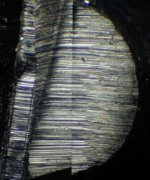Harry_Morant
Bronze Member
I see a lot of posts and videos when people find a bullet which is not deformed in any way and people have a tendency to call it a "dropped" bullet. I was recently watching a British show called 'Two men in a Trench" where these two Brits do battlefield archaeology and they were test firing some muskets through a scottish wooden shield, some pork ribs and then into sandbags to see how far a musket round would penetrate. What amazed me (and them by the way) was that not only did the musket round penetrate the wood shield, ribs and deep into the sandbags that when they recovered it that it wasn't deformed.
They said that normally if they had found this round in this condition on a dig they would have previously assumed that it had been dropped. They are now rethinking the whole dropped round thing. There's a good chance that many of the 'drop' have actually been fired but not deformed on impact.
Thought?
They said that normally if they had found this round in this condition on a dig they would have previously assumed that it had been dropped. They are now rethinking the whole dropped round thing. There's a good chance that many of the 'drop' have actually been fired but not deformed on impact.
Thought?
Upvote
0




